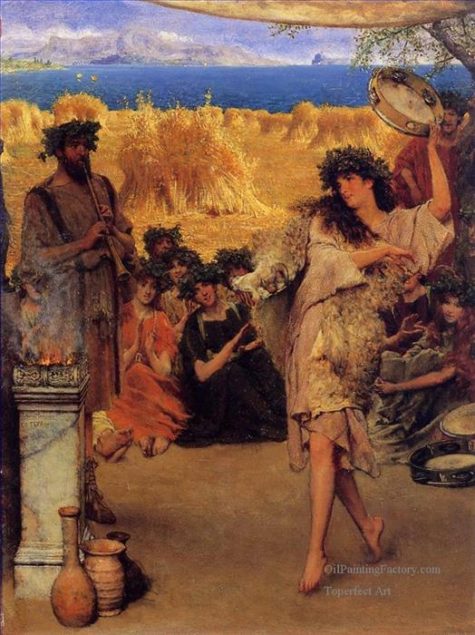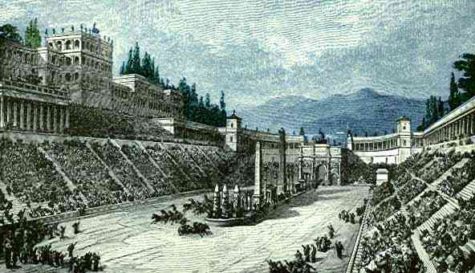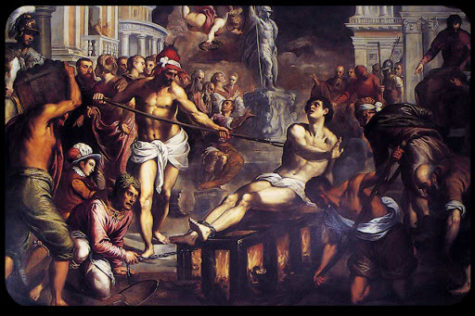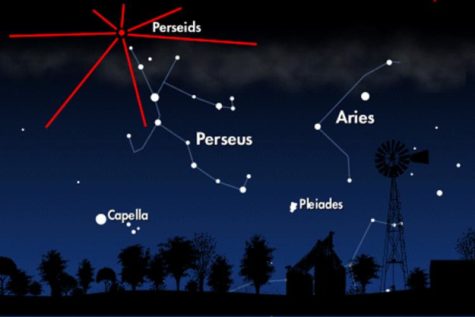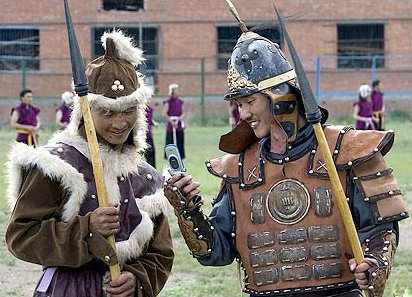In Spanish-speaking countries, instead of Friday, Tuesday the 13th is considered a day of bad luck, commonly referred to as ‘Martes y trece‘ (Literally translates to: Tuesday and thirteen).
The Greeks also consider Tuesday (and especially the 13th) an unlucky day. Tuesday is considered dominated by the influence of Ares, the god of war. A connection can be seen in the etymology of the name in some European languages (Mardi in French or martes in Spanish).
The fall of Constantinople to the Fourth Crusade occurred on Tuesday, April 13, 1204 and the Fall of Constantinople to the Ottomans happened on Tuesday, May 29, 1453, events that strengthen the superstition about Tuesday.
In addition, in Greek the name of the day is Triti (Τρίτη) meaning literally the third (day of the week), adding weight to the superstition, since bad luck is said to “come in threes”.
Found at Wikipedia
August 25th is the Opconsivia, (or Opeconsiva or Opalia) the harvest festival of Ops, the Roman goddess of agricultural resources and wealth, also known as Opis. The festival marked the end of harvest, with a mirror festival on December 19 concerned with the storage of the grain.
- Themes: Opportunity; Wealth; Fertility; Growth
- Symbols: Bread; Seeds; Soil
About Ops: This Italian goddess of fertile earth provides us with numerous “op-portunities” to make every day more productive. In stories, Ops motivates fruit bearing, not just in plants but also in our spirits. She also controls the wealth of the gods, making her a goddess of opulence! Works of art depict Ops with a loaf of bread in one hand, and the other outstretched, offering aid.
To Do Today:
On this day, Ops was evoked by sitting on the earth itself, where she lives in body and spirit. So, weather permitting, take yourself on a picnic lunch today. Sit with Ops and enjoy any sesame or poppy breadstuff (bagel, roll, etc.) – both types of seeds are magically aligned with Ops’s money-bringing power. If possible, keep a few of the seeds from the bread in your pocket or shoe so that after lunch, Ops’s opportunities for financial improvements or personal growth can be with you no matter where you go. And don’t forget to leave a few crumbs for the birds so they can take your magical wishes to the four corners of creation.
If the weather doesn’t cooperate, invoke Ops by getting as close to the earth as you can (sit on your floor, go into the cellar). Alternatively, eat earthy foods like potatoes, root crops, or any fruit that comes from Ops’s abundant storehouse.
More About This Festival:
The Latin word consivia (or consiva) derives from conserere (“to sow”). Opis was deemed an underworld goddess who made the vegetation grow. Since her abode was inside the earth, Ops was invoked by her worshipers while sitting, with their hands touching the ground.
Although Ops is a consort of Saturn, she was also closely associated with Consus, the protector of grains and subterranean storage bins (silos). The festival of Consus, the Consualia, was celebrated twice a year, each time preceding that of Ops: once on August 21, after the harvest, and once on December 15, after the sowing of crops was finished.
The Opiconsivia festival was superintended by the Vestals and the Flamines of Quirinus, an early Sabine god said to be the deified Romulus. The main priestess at the regia wore a white veil, characteristic of the vestal virgins. A chariot race was performed in the Circus Maximus. Horses and mules, their heads crowned with chaplets made of flowers, also took part in the celebration.
Sources: Wikipedia and 365 Goddess
On August 21, the ancient Romans celebrated the Consualia, a festival, with games, in honour of Consus, the god of secret deliberations.
It was solemnized every year in the circus, by the symbolical ceremony of uncovering an altar dedicated to the god, which was buried in the earth. This was because Romulus, who was considered the founder of the festival, was said to have discovered an altar in the earth on that spot.
The solemnity took place on the 21st of Augusta with horse and chariot races, and libations were poured into the flames which consumed the sacrifices. During these festive games, horses and mules were not allowed to do any work, and were adorned with garlands of flowers.
This festival is associated with the “Rape of the Sabine Women.” When after the building of Rome the Romans had no women, it is said, and when their suit to obtain them from the neighboring tribes was rejected, Romulus spread a report, that he had found the altar of an unknown god buried under the earth. The god was called Consus, and Romulus vowed sacrifices and a festival to him, if he succeeded in the plan he devised to obtain wives for his Romans. According to legend, it was at the first celebration of the Consualian Games that the Sabine maidens were carried off. The purpose being to populate the newly built town of Rome.
Note: Consus was eventually identified with Neptunus Equester, the alias and counterpart of Poseidon Hippios (Neptune), who was the founder of Atlantis, where, according to Plato, horses (hippos, equus) originated. Hence the connection with the animal.
When told by Roman officials to surrender the church’s valuables, St. Lawrence brought the city’s poor and sick. “Here is the church’s treasure,” he said.
Rome didn’t find this amusing, and legend says he was put to death in A.D. 258 by being roasted on a grate, although some scholars say he was more likely beheaded. In either case, folks in southern Europe still mark this day.
- It is customary there to eat only cold meat in recognition of the reputed manner of his death.
- Fair weather on St. Lawrence’s Day presages a fair autumn.
To do on Saint Lawrence’s Day:
Tonight, or especially tomorrow night and up to the dawn of August 12, if you look up at a clear sky in the Northern hemisphere, you may be blessed to see the Perseids meteor shower. This meteor shower is known as “the tears of St. Lawrence” because it is most visible at this time of year, though these streaks of light can sometimes be seen as early as 17 July and as late as 24 August.
To see St. Lawrence’s “fiery tears,” go outside after midnight, to a place as far away as possible from city lights (leave the city, if possible, and drive toward the constellation so that the city lights’ glow will be behind you). Lie down on the grass and look up and toward the North, about halfway between the constellation Perseus 3 — which will be very, very low on the horizon to the northeast — and the point directly overhead. Scan the sky elsewhere, too, but this area will be the most likely place to see the meteors.
If the sky is too cloudy or the Moon is too full for you to get a good view of the stars, you might not have any luck at all — but there will always be next year to try again!
When you see a “shooting star,” make a wish, as folklore says that wishes made when seeing such a star come true. Better yet, make the “wish” a prayer, and invoke St. Lawrence to pray it with you!
The darkness is no darkness with me,
but the night is as clear as the dawning,
that shineth more and more unto the perfect day.
~Saint Lawrence
As to foods, aside from the European custom of eating only cold meat, there is nothing else in particular associated with this day that I am aware of. However, given St. Lawrence’s mode of death, a barbecue might make for an interesting choice. Grill some meats and vegetables, have a nice cooler of beer, and prepare for a late night of star-gazing and recalling the glory of St. Lawrence! Continue reading
July 29, is the festival of the Anglo-Saxon god Thunor and the Norse god Thor, a time of ascendant power and order. The great thunder-God Thor was honored on this date with prayers for protection of the crops against destructive storms in the older times in Europe.
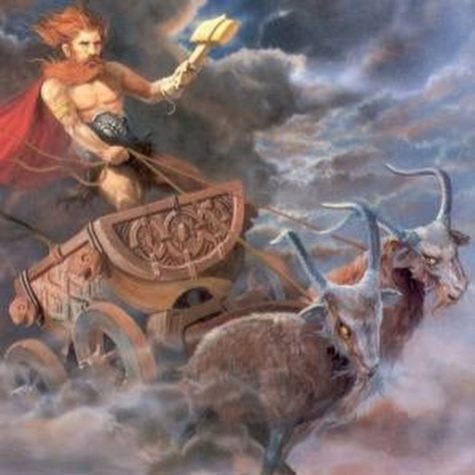
Prayer to Thor for Strength
by Seawalker
Thunder rolls, lightning strikes,
And the hammer flies across the sky.
God of the weather, chariot of the storm,
Master of rain and torrents,
Son of the strength of Mother Earth,
I ask you to grant me that strength for myself.
You who are so great that you cannot walk
Across the Rainbow Bridge without breaking it,
You whose tree is the mighty oak,
O Thunor, grant me that unending sturdiness.
Let me not break beneath the blows of misfortune.
Keep me from being crushed when the powerful
Stomp their large feet on the smaller ones below.
You who are the guardian of the common man,
You who care for the farmers and workers,
Look upon me here in this place where I am
Only one of many, and protect my steps.
Make me resilient and mighty as your own arm,
Make me unbreakable, you who are Friend of Man.
I ask for one small percentage of the vigor
Of the right arm of the Thunderer,
That I might brave the tempest
And stand firm in the gales.
Thunder rolls, lightning strikes,
And the hammer flies across the sky.
Found at Thor’s Shrine
On July 25, in ancient Rome, the annual Furinalia (also spelled Furrinalia) took place in honor of the Goddess of springs, Furrina. This was the time when a drought might begin to “bite,” and the value of springs is appreciated. This is a good day to remember our vital reliance on sources of water and how important it is that they be kept clean and free of pollutants and contaminants.
Get set for the meteoritic grand finale of summer. The middle week of August is the peak of the Perseid meteor shower.
The Perseids is one of the best meteor showers to observe, producing up to 60 meteors per hour at its peak. It is produced by comet Swift-Tuttle, which was discovered in 1862. The Perseids are famous for producing a large number of bright meteors. The shower runs annually from July 17 to August 24. Best viewing will be from a dark location after midnight. Meteors will radiate from the constellation Perseus, but can appear anywhere in the sky.
It peaks this year (2017) on the night of August 12 and the morning of August 13. The waning gibbous moon will block out many of the fainter meteors this year, but the Perseids are so bright and numerous that it should still be a good show.
Of course, like with any meteor shower, it’s worth starting to watch a few days prior to the peak date. Although meteor streams like the Perseids have been modeled and mapped over the years, there are still lots of surprises out there. Plus, starting an early vigil is insurance that you at least catch some action in the event that you’re clouded out on game day! The Perseids are already active, spanning a season from July 17th to August 24th.
Here’s a sky map:
Source: SeaSky and other sources
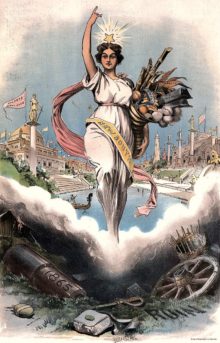 Commemorates the storming of the Bastille, which started the French Revolution, on July 14th, 1789. Bastille Day is also celebrated by many of France’s former and current colonies.
Commemorates the storming of the Bastille, which started the French Revolution, on July 14th, 1789. Bastille Day is also celebrated by many of France’s former and current colonies.
For A Magickal Bastille Day
- Theme: It’s time for a revolution!
- Colors: Blue, white, and red
- Symbols: The Eiffel Tower and the French national flag
- Presiding Goddess: Lady Liberty
About Lady Liberty:
Although, Lady Liberty is not a goddess in the true sense of the word, she is a potent symbol of freedom. The statue of Liberty was a gift to the United States from the people of France. The statue is of a robed female figure representing Libertas, the Roman goddess of freedom, who bears a torch and a tabula ansata (a tablet evoking the law) upon which is inscribed the date of the American Declaration of Independence, July 4, 1776. A broken chain lies at her feet. The statue is an icon of freedom. In 1793, during the French Revolution, the Notre Dame de Paris cathedral was turned into a “Cult of Reason” and for a time “Lady Liberty” replaced the Virgin Mary on several altars.
To do today:
Time to take stock of your life and circumstances. Is it time for a revolution in your life? Is it time to break down barriers, make new rules, give yourself permission to be free of oppressive situations and/or relationships? Is it time to draw up your own Declaration of Independence, or as the French termed it, the Declaration of the Rights of Man and of the Citizen?
Here is a spell for personal freedom:
This spell taps directly into the energy and power of Bastille Day, and can be performed any time it is needed. You will need a length of blue, white, and red ribbon or yarn. It should be as long as you are tall. You can use three ribbons, each a solid color, or one ribbon that is a combination of the three colors. You will also need an envelope, and a handful of dandelion fluff, or feathers, a small candle, and a knife or pair of scissors.
Light the candle, and then place the dandelion fluff into the envelope, and seal it shut. Those little bits of fluff or feathers represent your spirit. The envelope represents the walls you have created to protect yourself. Carefully fold or roll the envelope up so that will fit comfortably in your hand. You control your own destiny. It lies in your hands now.
Sit down, holding the envelope, and think about what restricts your freedom, what circumstances and situations starve your spirit, and steal your joy, what binds you, what constricts you, what holds you back. Begin to tie the ribbon around the envelope. There is no wrong way to bind up the envelope with the ribbon. Tie as many knots as you’d like. While you are binding the envelope, be thinking about the restrictions that bind your spirit. When you are complete, drip candle wax onto the bundle to seal it, and then snuff the candle.
Now, take the wrapped up envelope outside, along with the knife or scissors outside. Take a few moments to breathe in the outside air, listen to the sounds around you, notice the wind and the sky. You can be free. You can claim your freedom. Allow yourself to think about how it will feel to be free. When you are ready, begin to cut the strands of ribbon away from the envelope. As you do, say the following:
Bondage has no hold on me.
Beautiful Lady set me free.
When the ribbon is completely cut, very gently open the envelope and take out the dandelion fluff or feathers. Holding them in your hand, gently breathe into them and then hold them high and toss them free. Don’t worry if they simply fall to the ground. Any feathers or fluff that fails to fly free can be picked up and gently placed in an open spot where they will catch the breeze.
Burn or bury the remains of the envelope and the ribbon. When you go back inside, re-light your candle. You are now ready to let your own light shine. Allow the candle to burn completely.
About Bastille Day:
What follows is an excerpt from a Paris newspaper account of the fall of the Bastille, on July 14, 1789:.
It was a terrible scene. . . . The fighting grew steadily more intense; the citizens had become hardened to the fire; from all directions they clambered onto the roofs or broke into the rooms; as soon as an enemy appeared among the turrets on the tower, he was fixed in the sights of a hundred guns and mown down in an instant;
meanwhile cannon fire was hurriedly directed against the second drawbridge, which it pierced, breaking the chains; in vain did the cannon on the tower reply, for most people were sheltered from it; the fury was at its height; people bravely faced death and every danger; women, in their eagerness, helped us to the utmost; even the children, after the discharge of fire from the fortress, ran her and there picking up the bullets and shot;
…and so the Bastille fell and the governor, De Launey, was captured … Serene and blessed liberty, for the first time, has at last been introduced into this abode of horrors, this frightful refuge of monstrous despotism and its crimes.
Interestingly, although the name of the Bastille evokes dark images of despotism and unjust imprisonment, in reality it was a great deal pleasanter than most ordinary prisons. A central part of the myth, and an indication of its potency, was the story of a prisoner supposedly forced to wear an iron mask to conceal his identity even from his guards – the sufferings of this Man in the Iron Mask were given wide publicity by Voltaire. Archives of the title reveal that there was indeed a masked prisoner from 1698 until 1703, when he died. The mask was made of velvet, and he was well treated.
It was originally built in the 14th century to guard one of main entrances to Paris, but by the 18th century the Bastille served only as a prison – mainly for political, aristocratic prisoners who could not be thrust into the crowded gaols with common criminals – and occasionally as a store for arms.The fortress also accommodated printers, booksellers and authors who produced works that the authorities considered seditious. Voltaire was imprisoned there twice: first in 1717 when he was suspected of writing verses accusing the Régent of incest, and then again in 1726. Throughout the 18th century there were never more than 40 inmates, most of them serving short sentences.
On the morning of 14 July 1789, the Bastille was nearly empty of prisoners, housing only seven old men annoyed by all the disturbance: four forgers, two “lunatics” and one “deviant” aristocrat, the Comte de Solages (the Marquis de Sade had been transferred out ten days earlier). The cost of maintaining a medieval fortress and garrison for so limited a purpose had led to a decision being taken to close it, shortly before the disturbances began. It was, however, a symbol of royal tyranny.
Upon learning that the Bastille had been taken, King Louis XVI, who was residing at Versailles, was reported to have asked an informer: “Is this a revolt?” and La Rochefoucauld-Liancourt said, “No, Sire, it is a revolution.” Little did Louis know that the mob’s next plan was to march to Versailles, and take him away with them as well.
Note: This post was put together by Shirley Twofeathers you may repost and share it only if you give me credit and a link back to this website. Blessed be.
The Delta Aquarids is an average meteor shower that can produce up to 20 meteors per hour at its peak. It is produced by debris left behind by comets Marsden and Kracht. The shower runs annually from July 12 to August 23. Best viewing will be from a dark location after midnight. Meteors will radiate from the constellation Aquarius, but can appear anywhere in the sky.
Source: SeaSky
Naadam is the most widely watched festival among Mongols, and is believed to have existed for centuries in one fashion or another. Naadam has its origin in the activities, such as military parades and sporting competitions such as archery, horse riding and wrestling, that followed the celebration of various occasions. Now it formally commemorates the 1921 revolution when Mongolia declared itself a free country.
The biggest festival is held in the Mongolian capital Ulaanbaatar during the National Holiday from July 11 – 13, in the National Sports Stadium. Other cities and towns across Mongolia and those with significant Mongolian populations in China, have their own, smaller scale Naadam celebrations. It begins with an elaborate introduction ceremony featuring dancers, athletes, horse riders, and musicians. After the ceremony, the competitions begin.
Another popular Naadam activity is the playing of games using shagai, sheep anklebones that serve as game pieces and tokens of both divination and friendship. In the larger Nadaam festivals, tournaments may take place in a separate venue.
Source: Wikipedia

